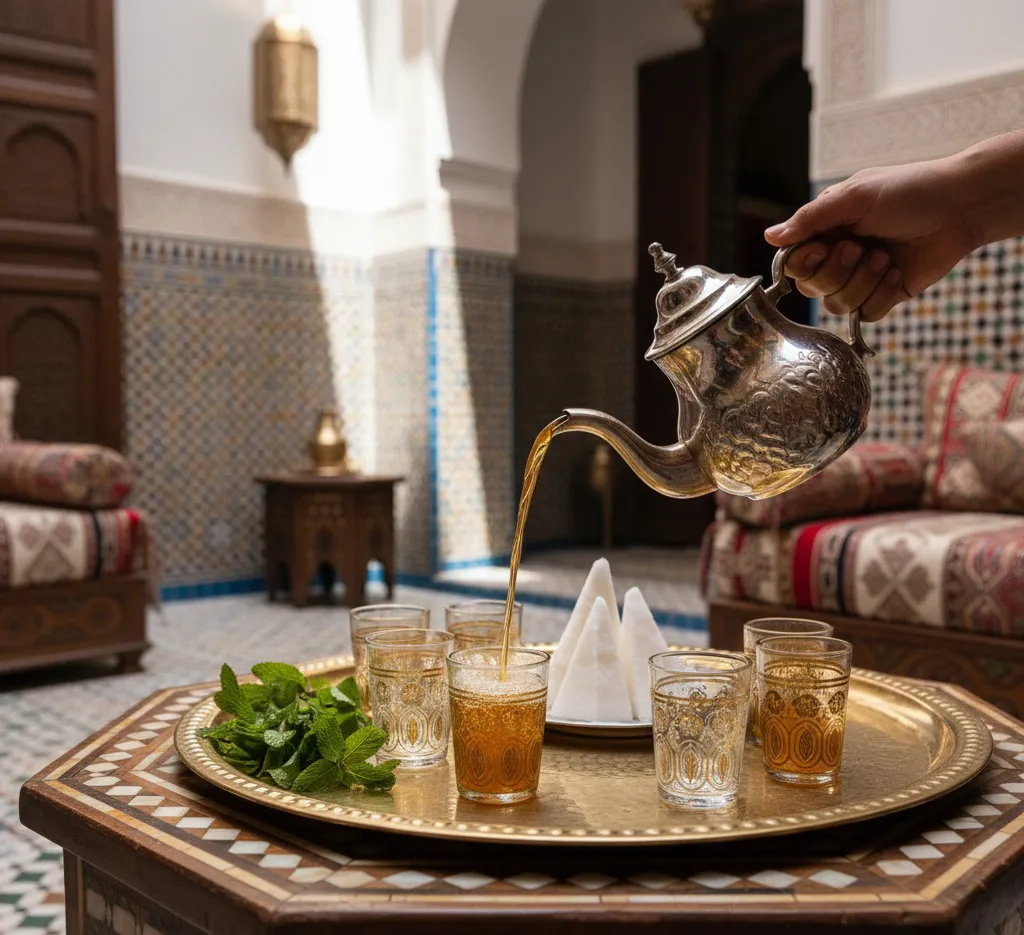As I sat in a Marrakech riad, the sound of pouring liquid echoed like a waterfall, the first sign I was about to experience something extraordinary. The steam carried minty freshness that reminded me of mountain breezes, while the sweet aroma told stories of hospitality and tradition. Moroccan mint tea isn’t just a drink, it’s the liquid heart of a culture, a ritual that binds communities, and a journey through history in a single glass. In this ultimate guide, we’ll explore every aspect of this iconic beverage, from its historical roots to its modern global influence, revealing why it remains North Africa’s most cherished cultural treasure.
Table of Contents
The History and Origin of Moroccan Mint Tea
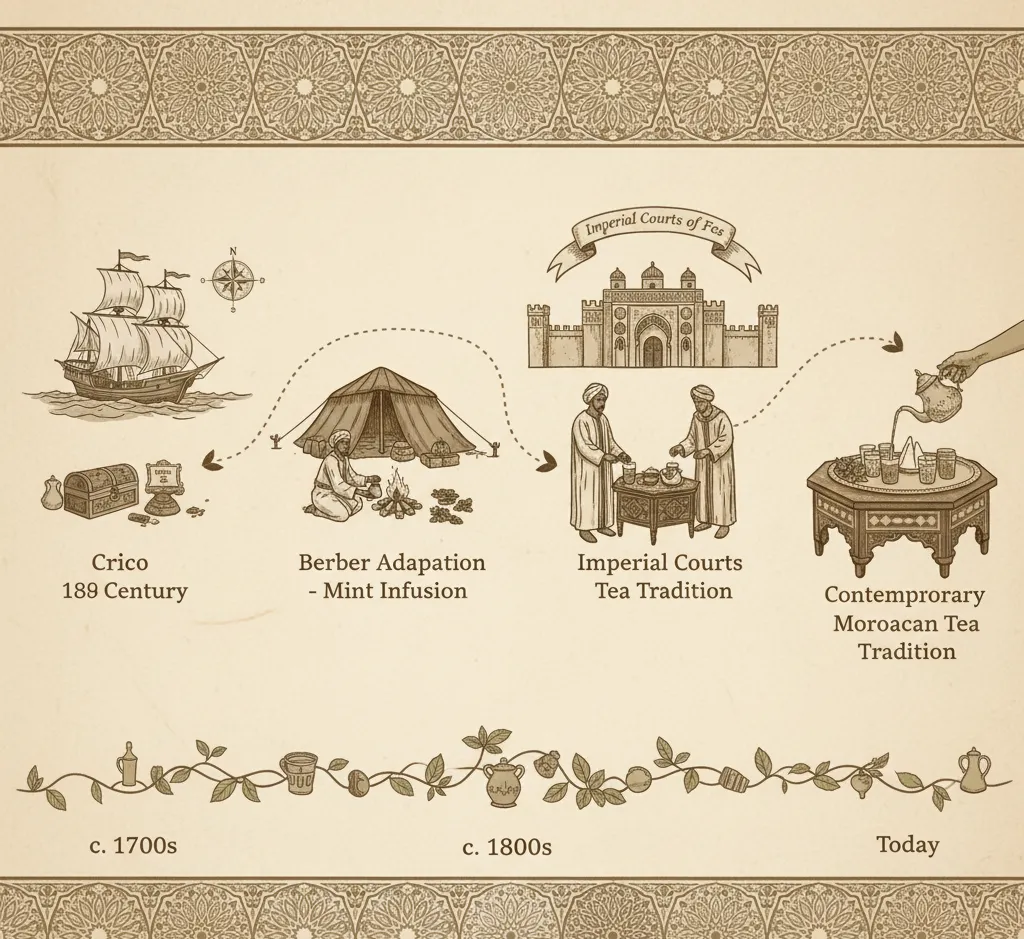
The story of Moroccan mint tea begins with the Berbers, Morocco’s first inhabitants, who introduced fundamental culinary practices that endure today. When the Arabs arrived in the 7th century, they brought crucial elements that would shape the tea’s identity: spices from China, India, and Malaysia, and the concept of sweetened beverages. The tea tradition itself arrived much later, through trade routes in the 18th century, when British merchants introduced green tea to Morocco. The Moroccans’ genius lay in transforming Chinese gunpowder tea into something uniquely their own by adding fresh mint and copious sugar, creating a blend that perfectly suited their climate and culture.
Berber Foundations and Arab Influence
The Berbers established culinary traditions that made Moroccan mint tea possible. They developed slow-cooking methods and preservation techniques that influenced how food and beverages were prepared. When the Arabs arrived, they introduced spices and sweetening agents that would become essential to the tea’s flavor profile. The famous Moroccan courts of the imperial cities, Fes, Meknes, Rabat, and Marrakech, refined the tea preparation into an art form, elevating it from a simple beverage to a cultural symbol.
I recall my first encounter with traditional tea preparation in a Berber village near the Atlas Mountains. An elderly woman showed me how her grandmother used local herbs before mint became the dominant flavor. “We used what the mountains gave us,” she said through a translator, “but when mint arrived, it changed everything.” This evolution mirrors Morocco’s history, as it adapts foreign influences while maintaining a distinct identity.
The Essential Ingredients: Gunpowder Tea, Moroccan Mint, and Sugar
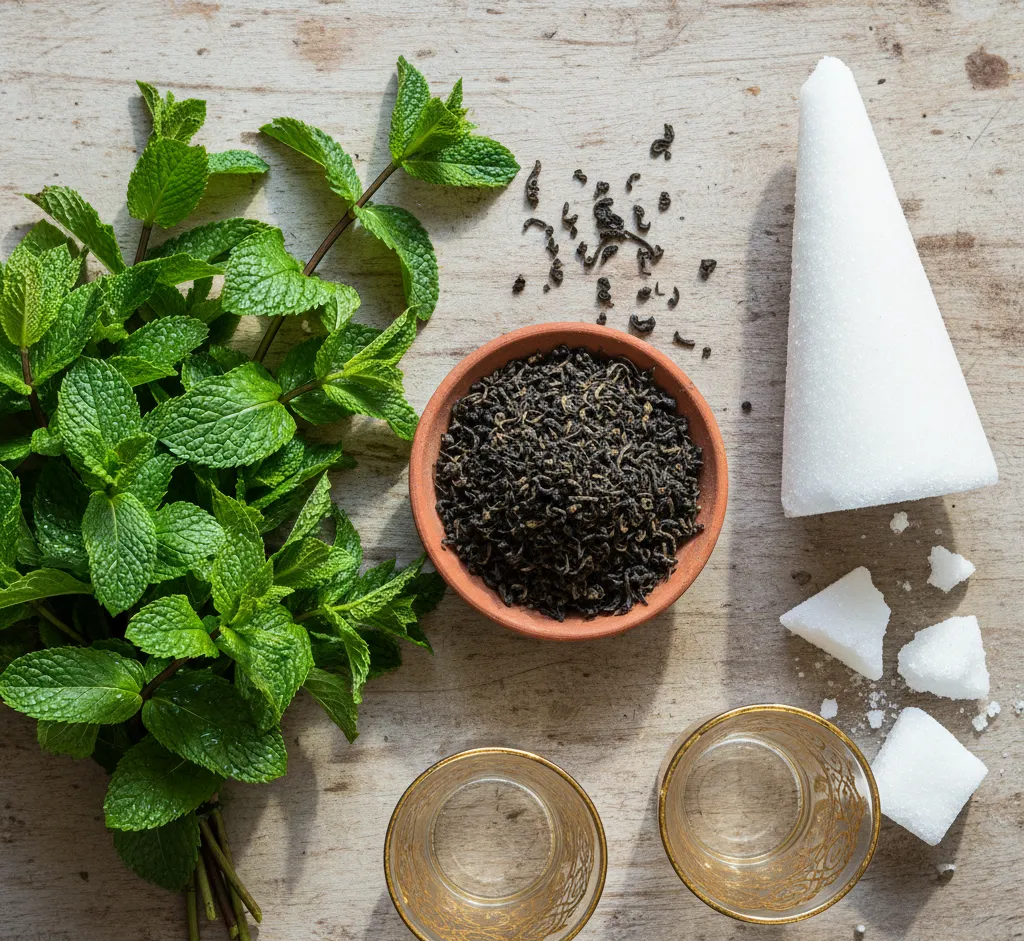
Authentic Moroccan mint tea requires three key components, each playing a crucial role in creating the perfect balance of flavors. Chinese gunpowder tea forms the base, its tightly rolled leaves unfurling during brewing to release robust, slightly smoky notes that complement the mint’s intensity. Moroccan spearmint (Mentha spicata) provides the refreshing signature flavor, ideally harvested from the fertile regions near the Atlas Mountains. Finally, sugar, often in large quantities, creates the sweet counterpoint that makes this tea uniquely Moroccan.
| Ingredient | Role | Traditional Quantity |
|---|---|---|
| Gunpowder Tea | Base with tannic structure | 1 tablespoon per 500ml |
| Fresh Spearmint | Refreshing flavor | Large handful |
| Sugar | Sweet balance | 4-5 teaspoons per serving |
During my stay in Rabat, a tea merchant explained why Moroccan mint differs from other varieties. “The altitude and soil composition in the Atlas foothills create mint with higher menthol content and smaller leaves,” he revealed while rubbing fresh sprigs between his fingers to release their aroma. This terroir effect reminds us that place matters as much as process in creating authentic flavors.
How to Make Authentic Moroccan Mint Tea: Traditional Recipe & Method
Creating perfect Moroccan mint tea involves both precision and ceremony. Begin by rinsing the gunpowder tea leaves in warm water to reduce bitterness, a step I once witnessed a Marrakech tea master perform with theatrical flourish. The first infusion develops the tea’s base notes, while the second infusion incorporates mint and sugar. The magic happens during the pouring process, where aerating the liquid between glasses creates the characteristic froth and releases aromatic compounds.
Step-by-Step Traditional Preparation
First, add gunpowder tea to the pot and cover with a small amount of boiling water. Swirl gently and discard this initial rinse after 30 seconds, this opens the leaves and removes excess tannins. Next, add fresh mint sprigs and sugar to the pot before pouring in boiling water. Allow the tea to steep for 3-5 minutes over low heat, letting the flavors meld together. The final step involves pouring from height into glasses, then returning the tea to the pot, repeating this process several times to ensure proper mixing and aeration.
I learned the importance of patience during my tea education in Fes. My host family laughed good-naturedly as I initially struggled with the pouring technique, creating more mess than elegance. “The height isn’t for show,” the father explained kindly. “It cools the tea to perfect drinking temperature while creating the necessary foam.” After three days of practice, I finally achieved the satisfying froth that indicates properly prepared tea.
The Art and Symbolism of the Moroccan Tea Ceremony
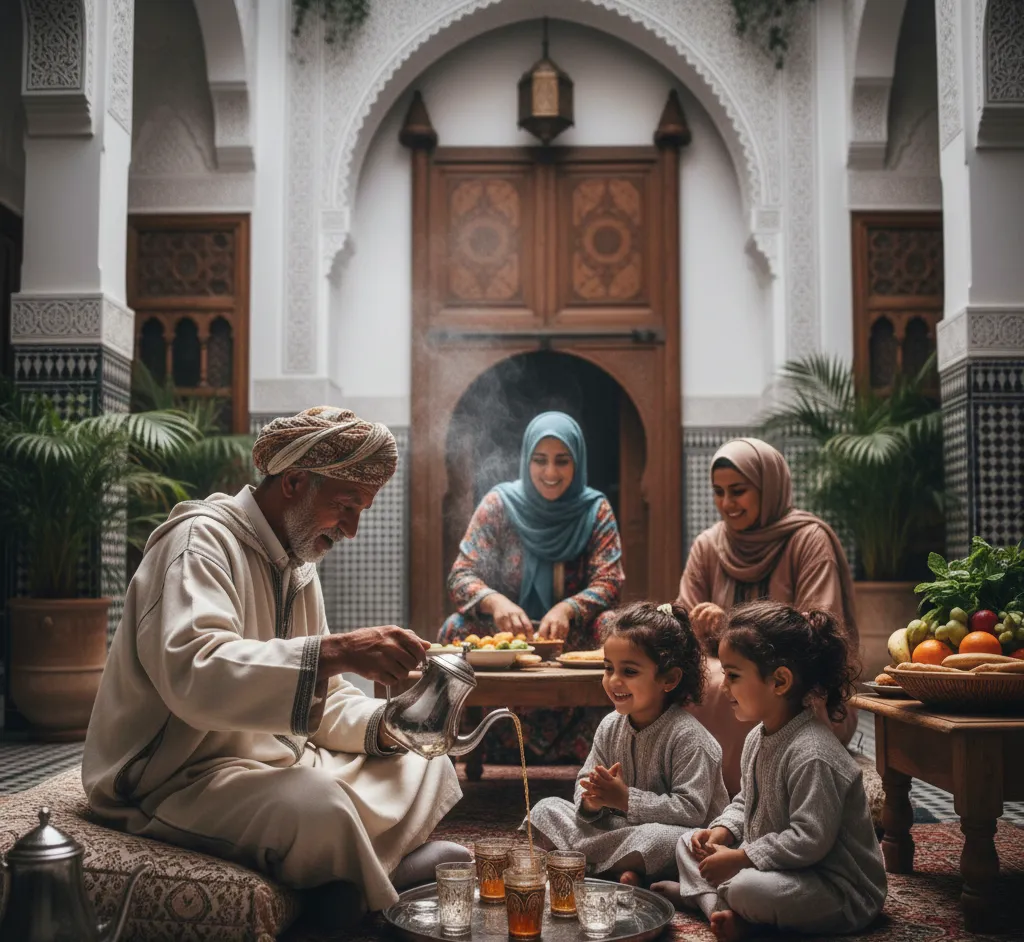
The Moroccan tea ceremony represents far more than beverage preparation, it’s a choreographed performance expressing cultural values of hospitality, relationship-building, and artistic expression. Every element carries meaning, from the specific pouring height (demonstrating respect for guests) to the number of times tea is poured back into the pot (ensuring perfect integration of flavors). The ceremony follows unwritten rules learned through observation and practice, making it both an art form and a social language.
During a business negotiation in Casablanca, I witnessed how the tea ceremony served as a diplomatic tool. The host’s pouring technique communicated subtle messages, a high pour indicated respect, while deliberately filling glasses only halfway suggested more discussion was needed. This unspoken communication system transforms tea service into a sophisticated social dance, where every movement carries significance beyond its practical function.
Regional Variations: From Tanger to the Sahara (Morocco, Algeria, Tunisia, Tuareg)
While Moroccan mint tea remains the most famous version, across North Africa’s Maghreb region, fascinating variations reflect local ingredients and traditions. Algerian tea often incorporates more bitter notes, using less sugar and sometimes adding wild herbs. Tunisian versions might include pine nuts or orange blossom water, creating entirely different sensory experiences. The nomadic Tuareg people prepare what locals call “Sahara whiskey”, a strong, minimally sweetened version served in small glasses that packs an energetic punch for desert conditions.
| Region | Unique Characteristics | Serving Style |
|---|---|---|
| Morocco | Sweet, heavy mint emphasis | Ornate glasses, poured from height |
| Algeria | Less sweet, sometimes bitter | Simple glasses, less ceremony |
| Tunisia | Orange blossom, pine nuts | Small cups, often with pastries |
| Tuareg | Strong, minimal sugar | Small glasses, focused on utility |
Traveling through the Maghreb, I discovered how tea preparation reveals cultural priorities. In coastal cities, tea was sweeter and served with elaborate pastries, while desert communities preferred stronger, less sweet versions that provided energy without attracting insects. These adaptations demonstrate how a single beverage evolves to meet environmental and cultural needs.
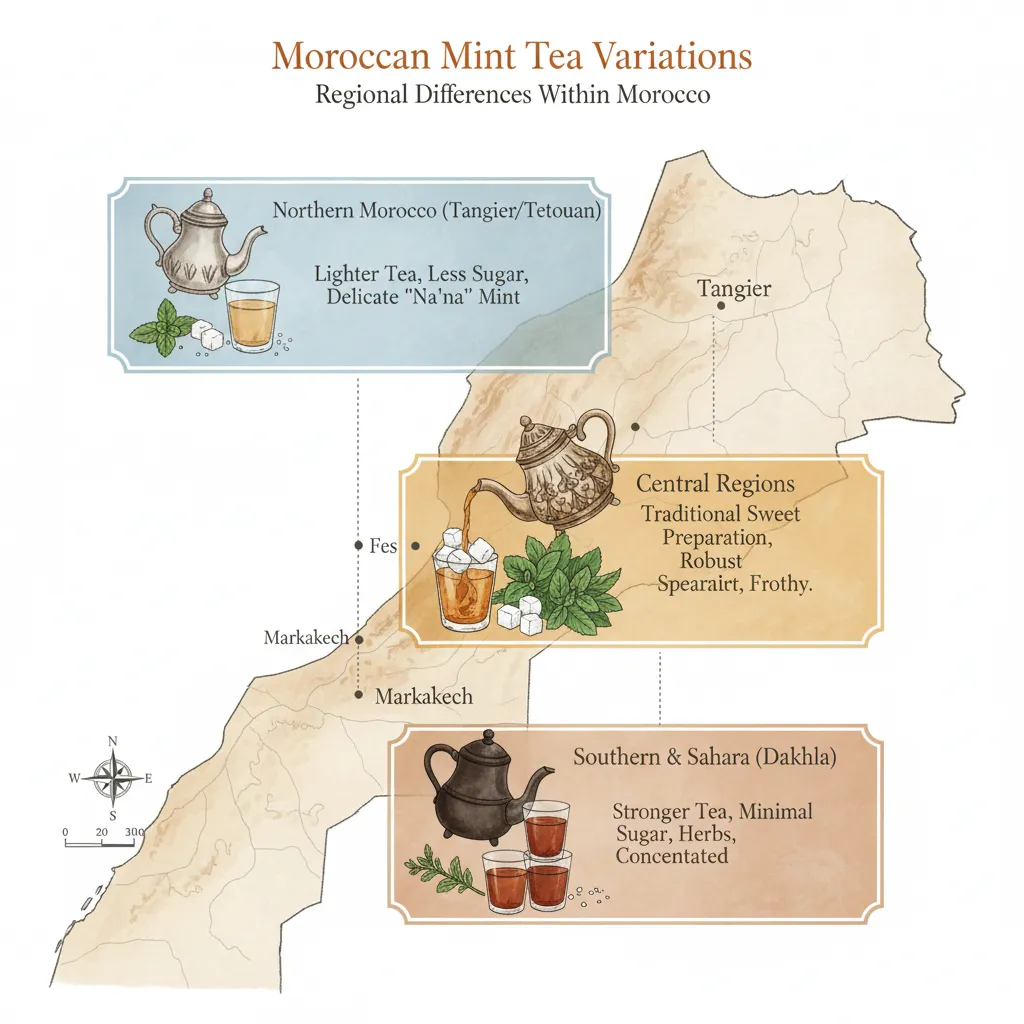
Science-Backed Health Benefits of Moroccan Mint Tea
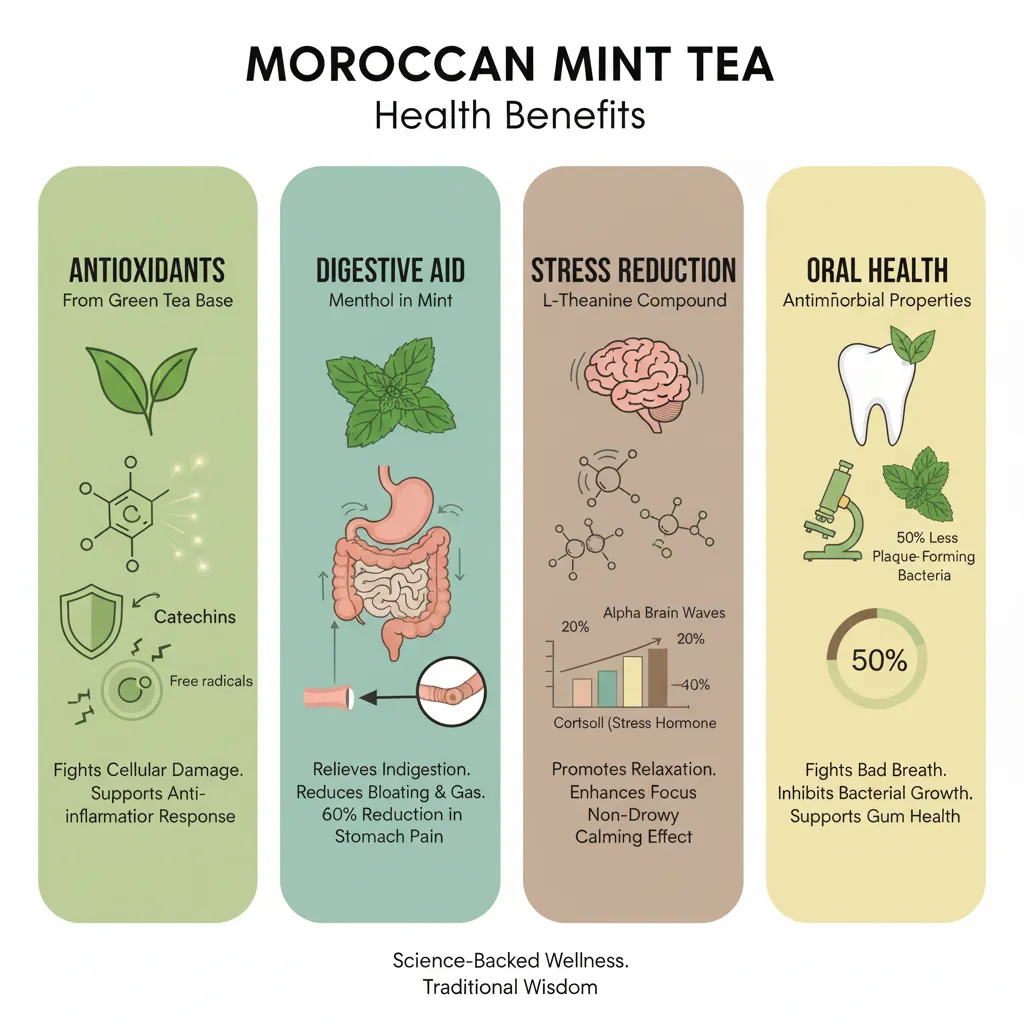
Beyond its delightful flavor, Moroccan mint tea offers impressive health benefits supported by scientific research. The gunpowder tea base contains catechins, potent antioxidants that combat oxidative stress and may reduce cardiovascular disease risk. Fresh mint provides menthol, which aids digestion and can relieve symptoms of irritable bowel syndrome. The combination also contains L-theanine, an amino acid that promotes relaxation without drowsiness, creating the calm alertness I’ve experienced during long conversation sessions in Moroccan medinas.
Recent studies have quantified what Moroccans have known for centuries. Research in the Journal of Ethnopharmacology found that regular consumption of mint tea can reduce stress markers by up to 25 percent. The polyphenols in green tea have been shown to improve cognitive function, while mint’s antibacterial properties support oral health. This scientific validation adds another layer to our appreciation of this ancient beverage.
Mint Cultivation in the Atlas Mountains and Sourcing Quality Ingredients
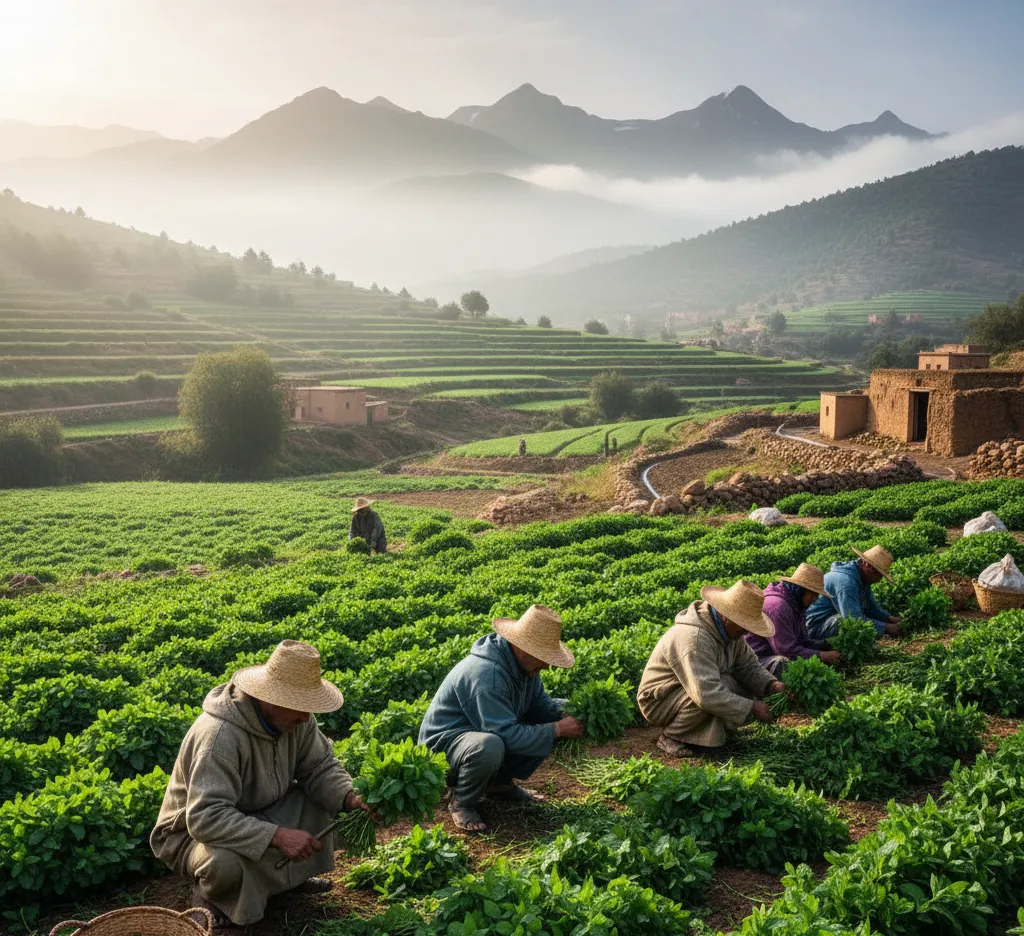
The unique character of Moroccan mint tea begins long before preparation, in the fertile foothills of the Atlas Mountains where ideal growing conditions create superior mint. The region’s mineral-rich soil, altitude (800-1,200 meters), and temperature variations produce spearmint with intense aroma and high essential oil content. Traditional farming methods avoid pesticides, relying instead on companion planting and natural solutions, practices I witnessed firsthand while visiting a cooperative near Ourika Valley.
Harvesting occurs early morning when essential oils are most concentrated. Farmers taught me to identify perfect leaves, vibrant green, unblemished, and approximately 10-15cm long. The best mint comes from plants in their second year, after they’ve developed robust root systems but before they become woody. This artisanal approach to ingredient sourcing distinguishes authentic Moroccan mint tea from imitations, much like terroir affects wine quality.
Cultural Significance: Hospitality, Islam, and Social Life in Morocco

In Morocco, serving mint tea transcends refreshment; it embodies core Islamic values of hospitality and community. The famous saying “Moroccan whiskey” humorously references the tea’s social importance despite alcohol prohibitions in Islam. Serving tea to guests represents both religious duty and cultural pride, with refusal considered deeply offensive. This tradition strengthens social bonds through shared experience, creating moments of connection in increasingly fragmented modern life.
During Ramadan, I observed how tea rituals adapted to fasting hours, becoming even more important during evening meals when families gathered after sunset. The preparation and sharing of tea created a structure for social interaction, allowing stories to be shared and relationships to be strengthened. This cultural role explains why Moroccans continue the tradition despite readily available alternatives like coffee or soft drinks, tea represents identity, not just preference.
The Traditional Tools: Choosing a Teapot (Berrad) and Glasses
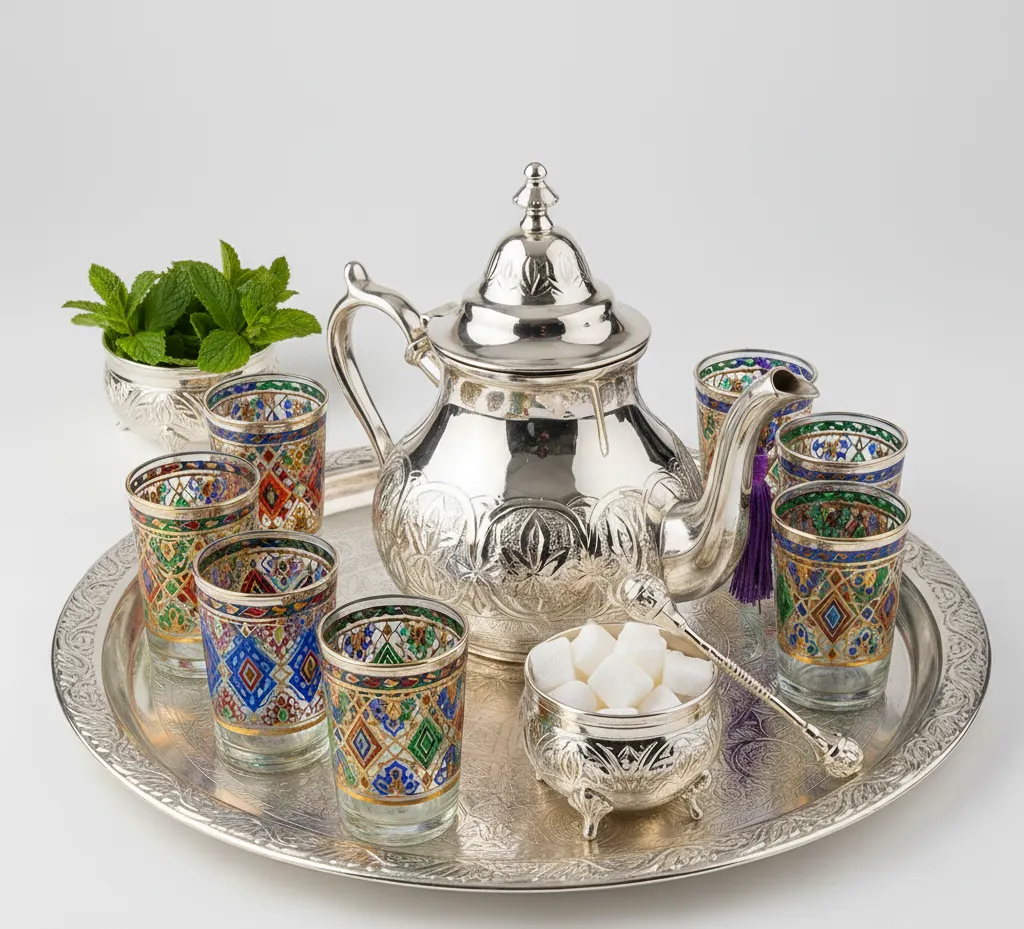
Authentic Moroccan tea preparation requires specific equipment, each piece reflecting centuries of refinement. The teapot (berrad) features distinctive design elements, a long curved spout for controlled pouring, a heat-resistant handle, and a dome-shaped lid that condenses steam efficiently. Traditional pots are made from polished stainless steel or silver, though modern versions sometimes use enameled steel. The glasses, colorful, ornate, and surprisingly heat-resistant, are designed to showcase the tea’s color while remaining comfortable to hold.
In Fes’s famous pottery district, I watched artisans create teapots using techniques unchanged for generations. The master craftsman explained subtle design features: “The spout’s curve isn’t just decorative, it controls flow rate for perfect pouring. The base thickness distributes heat evenly.” This marriage of form and function characterizes the best Moroccan craftsmanship, where beauty serves a practical purpose.
Moroccan Mint Tea Beyond the Cup: Influence on Skincare and Global Culture
The influence of Moroccan mint tea extends far beyond beverage culture into unexpected domains, including skincare, aromatherapy, and mixology. Luxury beauty brands like Red Flower incorporate mint tea extracts into purifying products, leveraging its antioxidant and antibacterial properties. Modern mixologists create tea-based cocktails that bridge cultural traditions, while aromatherapists use mint tea’s scent for its calming yet invigorating effects.
In New York, I encountered a bartender who created a “Moroccan Mint” cocktail using steeped gunpowder tea, fresh mint, and artisanal honey syrup. “The tea’s smoky depth complements spirits differently than traditional mixers,” he explained while preparing what became my favorite drink. This cultural adaptation demonstrates how traditional elements find new relevance in global contexts, creating dialogue between cultures through flavor.
FAQs About Moroccan Mint Tea
What is the difference between Moroccan mint tea and other mint teas?
Moroccan mint tea differs through its specific ingredients (Chinese gunpowder tea, Moroccan spearmint, significant sugar), preparation method (multiple infusions, high pouring), and cultural context (served as a hospitality ritual). Other mint teas may use different tea bases, less sugar, or alternative mint varieties.
Why is Moroccan mint tea poured from a height?
The high pour serves multiple purposes: it aerates the tea, creating desirable froth, mixes ingredients thoroughly, cools the tea to an ideal drinking temperature, and demonstrates skill and respect for guests through theatrical presentation.
How much sugar is traditionally used in Moroccan mint tea?
Traditional recipes use 4-5 teaspoons per serving, creating a notably sweet beverage. This historically reflected sugar’s status as a luxury item and helped preserve energy in hot climates. Modern preparations sometimes reduce sugar for health reasons.
What does the Moroccan saying about the three glasses of tea mean?
The proverb “The first glass is as gentle as life, the second is as strong as love, the third is as bitter as death” reflects tea’s changing flavor through multiple infusions and serves as a metaphor for life’s journey. It also encourages sharing three glasses with guests.
Can I make Moroccan mint tea if I can’t find fresh spearmint?
While fresh spearmint is ideal, quality dried spearmint can substitute in approximately a 1:3 ratio (dried: fresh). The flavor profile will differ slightly, but still produce delicious tea. Avoid peppermint as its stronger menthol overpowers the gunpowder tea.
Conclusion: Embracing the Moroccan Tea Tradition
Through my journeys across Morocco, I’ve learned that mint tea represents far more than a beverage. It’s a living tradition connecting past to present, people to places, and hosts to guests. The ritual of preparation forces mindfulness in an increasingly distracted world, while the shared consumption builds bridges across cultures. As you explore Moroccan mint tea in your own kitchen or travels, remember that you’re participating in a centuries-old tradition that continues to evolve while honoring its roots. I encourage you to source quality ingredients, practice the pouring technique, and most importantly, share the experience with others, creating your own stories around this remarkable drink.
Have you experienced Moroccan mint tea in Morocco or at home? Share your stories and questions in the comments below, and consider exploring other aspects of Moroccan cuisine, like couscous or tagine cooking, to deepen your understanding of this rich culinary tradition.

